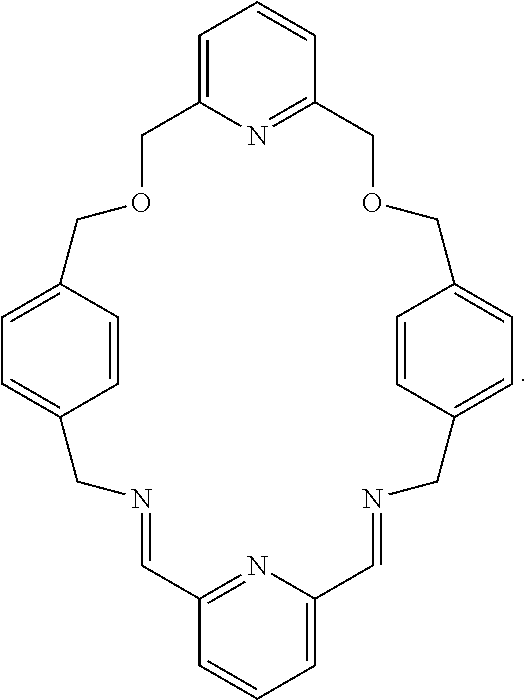Pseudorotaxanes, rotaxanes and catenanes formed by metal ions templating
a technology of metal ions and pseudorotaxane, which is applied in the field of host complexes or interlocked molecules, can solve the problems of limiting the number of recognition motifs that can be exploited for the preparation of these systems, lack of structural flexibility of recognition units, and impede the application of unique functions or structures to already practically used materials. and/or biologically
- Summary
- Abstract
- Description
- Claims
- Application Information
AI Technical Summary
Benefits of technology
Problems solved by technology
Method used
Image
Examples
embodiment 1
Guest Molecules Containing a Urea Group
example 1
Urea 1
[0049]
[0050]In this example, urea 1 having a urea group conjugated to two aromatic rings was used as the guest molecule. MC1 was used as the host molecule. Since the hydrogen bonding between urea 1 and MC1 and the on-dipole interaction between both of them and the metal ion template would both prefer less-polar solvents, sodium tetrakis(3,5-trifluoromethylphenyl)borate (NaTFPB) was chosen as the templating salt because of its relatively weak ion-pairing tendency in such solvents. The chemical structure of NaTFPB is shown below.
[0051]Urea 1, MC1, and NaTFPB were mixed in various molar ratios in CDCl3 for measuring 1H NMR spectra. The obtained 1H NMR spectra are shown in spectra 2C-2F in FIG. 2, respectively. In addition, the 1H NMR spectra of urea 1 as well as an equimolar mixture of urea 1 and MC1 are also shown in spectra 2A and 2B in FIG. 2 for comparison.
[0052]First, spectra 2B and 2C in FIG. 2 are compared. Spectrum 26 is the 1H NMR spectra of equimolar mixture of urea 1 a...
example 2
Urea 2
[0054]
[0055]In this example, urea 2 having a urea group conjugated to two aromatic rings was used as the guest molecule. NaTFPB was used as the templating salt. SA1 was used as the stoppering agent. MC1, MC2 and MC3 were respectively used as the host molecule. Di-n-butyltin dilaurate (DBTDL) was used as a catalyst for capping the SA1 to the urea 2. For preparing the rotaxanes 1-3, a CH2Cl2 solution containing urea 2, NaTFPB, one of the host molecules, and DBTDL was added with SA1, and then stirred at ambient temperature for 16 hours.
[0056]The macrocycle interlocked in rotaxane 2 is MC2, in which the two diethylene glycol motifs in MC1 were replaced by a triethylene glycol and a 2,6-bis(hydroxymethyl)pyridine units. The higher yield in the synthesis of rotaxane 2 compared to the one of rotaxane 1, suggested that the 2,6-bis(hydroxymethyl)pyridine unit is a more preorganized and better chelating motif, which energetically overcomes the increasing structural flexibility introduce...
PUM
 Login to View More
Login to View More Abstract
Description
Claims
Application Information
 Login to View More
Login to View More - R&D
- Intellectual Property
- Life Sciences
- Materials
- Tech Scout
- Unparalleled Data Quality
- Higher Quality Content
- 60% Fewer Hallucinations
Browse by: Latest US Patents, China's latest patents, Technical Efficacy Thesaurus, Application Domain, Technology Topic, Popular Technical Reports.
© 2025 PatSnap. All rights reserved.Legal|Privacy policy|Modern Slavery Act Transparency Statement|Sitemap|About US| Contact US: help@patsnap.com



